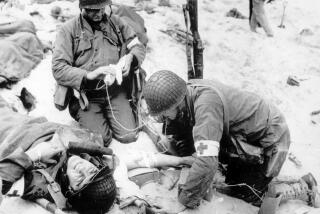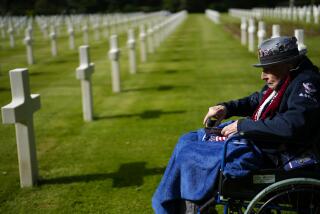A History Alive and Painful
- Share via
From 1989 through 1995, the United States marked successive 50th anniversaries of World War II, from the German advance into Poland through the Japanese surrender in Tokyo Bay. And that, many thought, would be that. Not that Americans would forget the war. But by natural process the war would recede from the consciousness of the present into the bloodless archives of history and academia. To a remarkable degree, that has not happened. The legacy of World War II continues to wrench society.
Just in the past year there have been a number of developments that hint at the extent to which the war dominated life throughout the world and remains with us still on this Memorial Day.
A few examples: the investigation of Nazi loot stashed in Switzerland and the controversy over the role of Swiss banks; the overwhelming audience for the first TV viewing of “Schindler’s List”; the ongoing hunt for war criminals; construction of a World War II memorial on the National Mall in Washington; the argument about how to memorialize the site of the camp at Manzanar in California where thousands of Japanese Americans were interned; scores of new books with new information and disclosures.
Not long ago, 72-year-old former President George Bush parachuted from an airplane over the Arizona desert to recall his jump from a flaming Navy torpedo bomber in 1944. A personal thing for Bush. But a former Navy man watching Bush commented: “He’s jumping for all of us World War II vets, to remind people of what we did.”
For all these isolated reminders, however, millions of Americans born since the war have little sense of how completely that conflict held the nation and the world in its awful grip. Battle directly embroiled some 70 million people from 57 countries. At least 20 million civilians died, although some sources put the toll much higher than that; no one will ever know how many for sure. The United States alone suffered more than 1 million casualties, including 292,131 combat deaths and 115,185 related fatalities.
Nearly 15 million Americans were in uniform in 1941-45. Millions of others worked in war plants. Gasoline, meat, butter and shoes were among the everyday products that were rationed on the home front so the military could be supplied. The production of new cars and other commercial goods was halted “for the duration.” No one had to ask the duration of what. There were victory gardens and war bond drives. School kids bought savings stamps for a dime each to help finance the war. There were blackouts and Civil Defense wardens, price and wage controls, propaganda and censorship. Hundreds of thousands of telegrams brought the dreaded word of a loved one killed or missing.
The war affected everyone. GIs risked their lives abroad and civilians sacrificed at home, with little protest or dissent.
World War II might seem remote now even for many who can remember. America is a much different place. An inescapable fact, however, is that America is very much what it is today as a result of what happened in those cataclysmic years so long ago.
More to Read
Sign up for Essential California
The most important California stories and recommendations in your inbox every morning.
You may occasionally receive promotional content from the Los Angeles Times.










